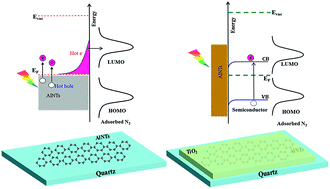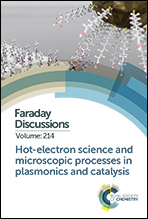Photocatalytic ammonia production enhanced by a plasmonic near-field and hot electrons originating from aluminium nanostructures†
Abstract
Ammonia production at room temperature and atmospheric pressure is in high demand to assist in energy saving and the protection of the environment worldwide, as well as to help reduce CO2 emissions. Recently, plasmonic nanomaterials have been frequently used for solar to chemical energy conversion, which has the potential to replace existing energy-intensive industrial processes. In our approach, plasmonic aluminium nanotriangles (AlNTs) were used to investigate the impact of plasmonic effects on photocatalytic ammonia production. Plasmonic near-field coupling to a semiconductor and hot electron generation from AlNTs were studied in detail through the use of electrochemical photocurrent measurements. A narrowband LED beam with a central wavelength at 365 nm was used to illuminate the AlNTs and their hot electron generation efficiency was estimated to be 2 × 10−4%, resulting in an ammonia production rate of 4 × 10−5 μM h−1 mW−1 cm−2, which corresponds to a quantum efficiency of 2.5 × 10−5%. In the case of plasmonic near-field coupling, AlNTs-embedded TiO2 demonstrates a charge-carrier generation efficiency of 2.7%, which is ∼2.3 times higher than that of bare TiO2. The ammonia production rate of AlNTs–TiO2 is 0.1 μM h−1 mW−1 cm−2 with a quantum efficiency of ∼0.06%, which corresponds to ∼2.4 times that of the rate demonstrated by bare TiO2 (0.04 μM h−1 mW−1 cm−2, quantum efficiency ∼ 0.025%). The obtained results confirm successful ammonia production through nitrogen splitting at room temperature and under atmospheric pressure. Moreover, according to the presented results, the use of plasmonic aluminium structures remarkably improves the ammonia production rate.

- This article is part of the themed collection: Hot-electron science and microscopic processes in plasmonics and catalysis


 Please wait while we load your content...
Please wait while we load your content...